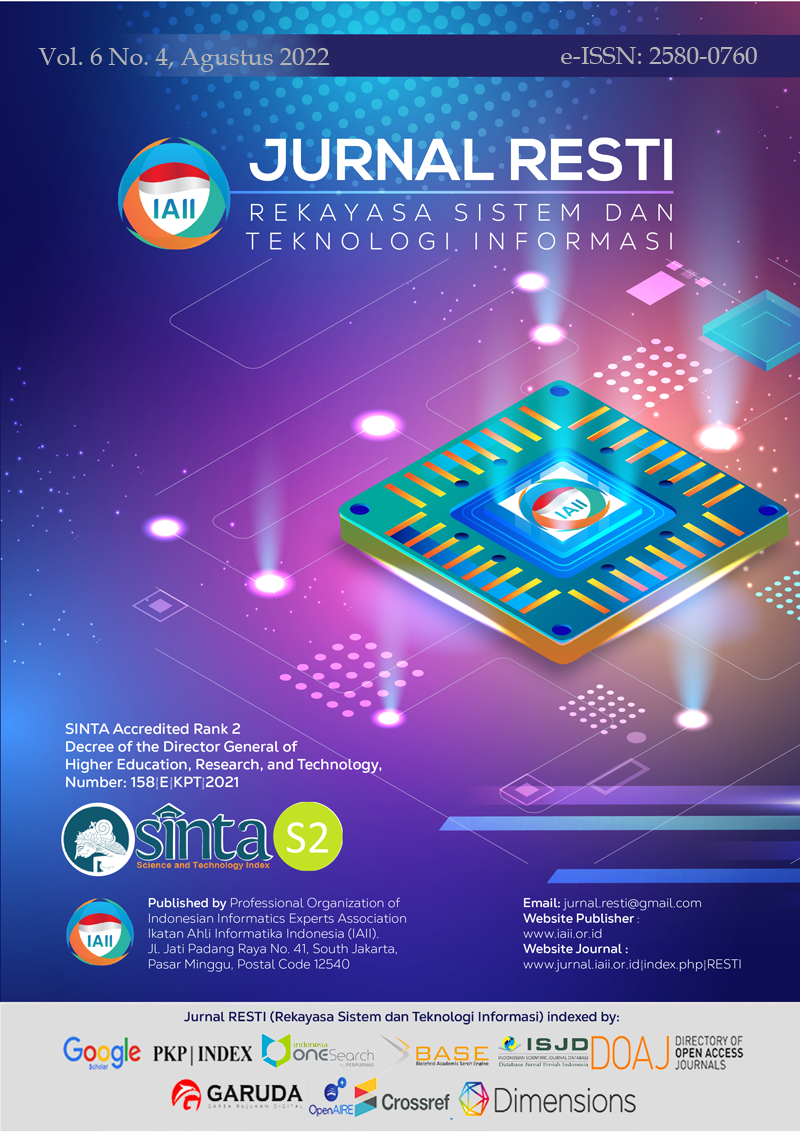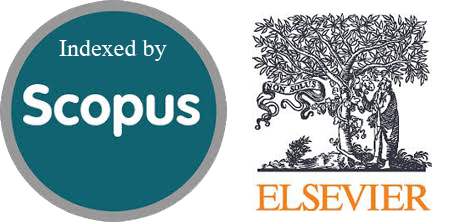Forecasting Pneumonia Toddler Mortality Using Comparative Model ARIMA and Multilayer Perceptron
Abstract
Pneumonia is an inflammatory lung disease that causes the second largest number of deaths in Indonesia after Dengue Hemorrhagic Fever (DHF). In 2021, there was an increase in cases of 7.8% compared to the previous year, and was exacerbated by the Covid-19 pandemic. Predictive methods were needed to predict and compare the ARIMA and MLP methods, where the results of the best methods were selected for long-term forecasting. The research data used was from January 2014 – December 2021, with a total of 96 data. In choosing the best method, the basic error calculations used were Mean Absolute Deviation, Mean Squared Error, and Mean Absolute Percentage Error. This study aims to build a predictive model for the next period of pneumonia under-five mortality. These results can be used for government policy-making related to mortality prevention for the next period. The results showed that the MLP method was superior to ARIMA. Testing 28 mortality rate data using the final test result showed that the best method was MLP, with a hidden layer value of 2.2, a learning rate of 0.3, and an error percentage of 1.27%. The prediction results of the overall mortality rate of pneumonia under five in 2022 was predicted to be 136 people.
Downloads
References
Profil kesehatan indonesia. (2018). “Provil Kesehatan Indonesia 2018”. https://doi.org/10.1002/qj
Prabhakara, G. (2010). “Health Statistics (Health Information System)”. In Short Textbook of Preventive and Social Medicine. https://doi.org/10.5005/jp/books/11257_5
Kementerian Kesehatan RI. (2018). “INFODATIN Situasi Kesehatan Anak Balita di Indonesia”. Kementerian Kesehatan RI.
S. Eka, “Segmentasi Pelanggan Menggunakan Two Stage Clustering dan LRFM Model pada Divisi Marketing PT . XYZ untuk Mendukung Strategi Pengelolaan Pelanggan,” hal. 1–7, 2011.
T. Hardiani, S. Sulistyo, dan R. Hartanto, “Kajian Data Mining Customer Relationship Management pada Lembaga Keuangan Mikro,” J. Sist. Inf. Bisnis, vol. 4, no. 3, hal. 181–187, 2014, doi: 10.21456/vol4iss3pp181-186
Salwa, N., Tatsara, N., Amalia, R., & Zohra, A. F. (2018). “Peramalan Harga Bitcoin Menggunakan Metode ARIMA (Autoregressive Integrated Moving Average). Journal of Data Analysis, 1(1), 21–31. https://doi.org/10.24815/jda.v1i1.11874
Aribowo, A. B., Sugiarto, D., Marie, I. A., & Siahaan, J. F. A. (2020). “Peramalan harga beras IR64 kualitas III menggunakan metode Multi Layer Perceptron, Holt-Winters dan Auto Regressive Integrated Moving Average”. Ultimatics : Jurnal Teknik Informatika. https://doi.org/10.31937/ti.v11i2.1246
Paruntu, S. A., & Palandeng, I. D. (2018). “Sepeda Motor Suzuki Pada Pt Sinar Galesong Mandiri Malalayang Analysis of Sales Forecast and Inventory for Suzuki Motorcycle Products At Pt Sinar Galesong Mandiri Malalayang”. 6(4), 2828–2837.
Munandar, D. (2019). “Multilayer perceptron (MLP) and autoregressive integrated moving average (ARIMA) models in multivariate input time series data: Solar irradiance forecasting”. International Journal on Advanced Science, Engineering and InformationTechnology.https://doi.org/10.18517/ijaseit.9.1.6426
Masngut, M. A., Ismail, S., Mustapha, A., & Yasin, S. M. (2020). “Comparison of daily rainfall forecasting using multilayer perceptron neural network model”. IAES International Journal of Artificial Intelligence. https://doi.org/10.11591/ijai.v9.i3.pp456-463
Bhargavi, K. (2015). “USD Exchange Rate Forecasting using ARIMA , MLP and Recurrent Neural Networks”. 3(27), 1–4.
Ramadhani, F., Sukiyono, K., & Suryanty, M. (2020). “Forecasting of Paddy Grain and Rice’s Price: An ARIMA (Autoregressive Integrated Moving Average) Model Application”. SOCA: Jurnal Sosial, Ekonomi Pertanian, 14(2), 224. https://doi.org/10.24843/soca.2020.v14.i02.p04
Soraya, S., Nurhidayati, M., Herawati, B. C., Anggrawan, A., Putra, L. G. R., & D, D. (2021). “Forecasting Foreign Tourist Visits to West Nusa Tenggara Using ARIMA Method”. Jurnal Varian, 5(1), 89–96. https://doi.org/10.30812/varian.v5i1.1441
Haslina, Hasmah, Fitriani, K. W., Asbar, M., & Asrirawan. (2018). “Penerapan Metode ARIMA (Autoregressive Integrated Moving Average) Box Jenkins Untuk Memprediksi Pertambahan Jumlah Penduduk Transmigran (Jawa dan Bali) di Kecamatan Sukamaju, Kabupaten Luwu Utara Propinsi Sulawesi Selatan”. Dinamika.
Widodo, S. (2017). “Peramalan Jumlah Kasus Tuberkulosis Di Kabupaten Malang Menggunakan Metode Autoregressive Integrated Moving Average-Autoregressive Conditional Heteroscedasticity (Arima-Arch)”. 153. Retrieved from http://repository.its.ac.id/1767/
Kurniasih, N., Ahmar, A. S., Hidayat, D. R., Agustin, H., & Rizal, E. (2018). “Forecasting Infant Mortality Rate for China: A Comparison between α-Sutte Indicator, ARIMA, and Holt-Winters”. Journal of Physics: Conference Series, 1028(1), 0–6. https://doi.org/10.1088/1742-6596/1028/1/012195
Dewani, B. P., Suhartono, S., & Akbar, M. S. (2019). “Peramalan Jumlah Penumpang dan Barang di Bandar Udara Internasional Juanda dan Pelabuhan Tanjung Perak Menggunakan Model Hybrid ARIMAX dan Deep Learning Neural Networks”. Inferensi, 2(1), 1. https://doi.org/10.12962/j27213862.v2i1.6805
Hatta, H. H. M., Daud, F. M., & Mohamad, N. (2018). “An Application of Time Series ARIMA Forecasting Model for Predicting the Ringgit Malaysia-Dollar Exchange Rate”. Journal of Data Analysis. https://doi.org/10.24815/jda.v1i1.11884
Adeyemo, O. A. (2015). “Decision tree and Multilayer Perceptron algorithms for the Prediction of Typohoid Fever”. African Journal of Computing & ICT, 8
Sen, S., Sugiarto, D., & Rochman, A. (2020). Prediksi Harga Beras Menggunakan Metode Multilayer Perceptron (MLP) dan Long Short Term Memory (LSTM). Ultimatics : Jurnal Teknik Informatika. https://doi.org/10.31937/ti.v12i1.1572
Pratiwi, P. G., Gede, I. K., Putra, D., Purnami, D., & Putri, S. (2019). “Peramalan Jumlah Tersangka Penyalahgunaan Narkoba Menggunakan Metode Multilayer Perceptron”. 7(2), 0–7
Mukhtar, H., Muhammad, R., Reny Medikawati, T., & Yoze Rizki. (2021). “Peramalan Kedatangan Wisatawan Mancanegara Ke Indonesia Menurut Kebangsaan Perbulannya Menggunakan Metode Multilayer Perceptron”. Jurnal CoSciTech (Computer Science and Information Technology), 2(2), 113–119. https://doi.org/10.37859/coscitech.v2i2.3324
Kurniawan, I., Silaban, L. S., & Munandar, D. (2020). “Implementation of Convolutional Neural Network and Multilayer Perceptron in Predicting Air Temperature in Padang”. Jurnal RESTI (Rekayasa Sistem Dan Teknologi Informasi), 4(6), 2–7. https://doi.org/10.29207/resti.v4i6.2456
Aribowo, A. B., Sugiarto, D., Marie, I. A., & Siahaan, J. F. A. (2020). “Peramalan harga beras IR64 kualitas III menggunakan metode Multi Layer Perceptron, Holt-Winters dan Auto Regressive Integrated Moving Average”. Ultimatics : Jurnal Teknik Informatika. https://doi.org/10.31937/ti.v11i2.1246
Hanief, S., & Purwanto, A. (2017). “Peramalan Dengan Metode Exponential Smoothing dan Analisis Sistem Untuk Penentuan Stok ATK (Kertas A4)”. Jurnal Teknologi Informasi Dan Komputer. https://doi.org/10.36002/jutik.v3i1.229
Briggs, W., Makridakis, S., Wheelwright, S., Hyndman, R., & Diebold, F. (1999). “Forecasting: Methods and Applications”. Journal of the American Statistical Association. https://doi.org/10.2307/2669717
Ramchoun, H., Amine, M., Idrissi, J., Ghanou, Y., & Ettaouil, M. (2016). “Multilayer Perceptron: Architecture Optimization and Training”. International Journal of Interactive Multimedia and Artificial Intelligence. https://doi.org/10.9781/ijimai.2016.415
Awad, M., & Ewais, A. (2018). “Prediction of General High School Exam Result Level Using Multilayer Perceptron Neural Networks”. International Journal of Applied Engineering Research, 13(10), 7621–7630.
Sakinah, N. P., Cholissodin, I., & Widodo, A. W. (2018). “Prediksi Jumlah Permintaan Koran Menggunakan Metode Jaringan Syaraf Tiruan Backpropagation”. Jurnal Pengembangan Teknologi Informasi Dan Ilmu Komputer (J-PTIIK).
Mongkareng, D., Setiawan, N. A., & Permanasari, A. E. (2017). “Implementasi Data Mining dengan Seleksi Fitur untuk Klasifikasi Serangan pada Intrusion Detection System (IDS)”. Citee, (gambar 2), 314–321.
Copyright (c) 2022 Jurnal RESTI (Rekayasa Sistem dan Teknologi Informasi)

This work is licensed under a Creative Commons Attribution 4.0 International License.
Copyright in each article belongs to the author
- The author acknowledges that the RESTI Journal (System Engineering and Information Technology) is the first publisher to publish with a license Creative Commons Attribution 4.0 International License.
- Authors can enter writing separately, arrange the non-exclusive distribution of manuscripts that have been published in this journal into other versions (eg sent to the author's institutional repository, publication in a book, etc.), by acknowledging that the manuscript has been published for the first time in the RESTI (Rekayasa Sistem dan Teknologi Informasi) journal ;








